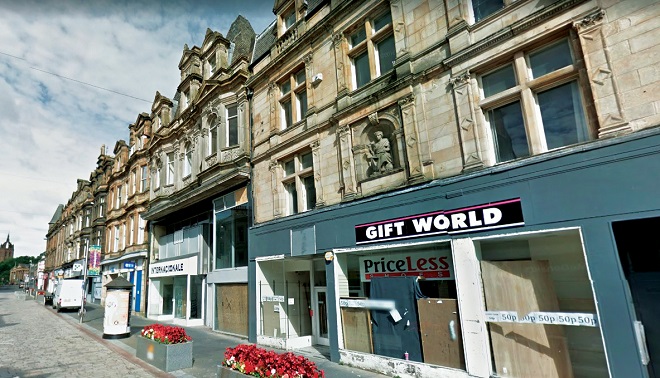TFN investigates how charities are faring on the high street and what the future holds for charity retail
Toys R Us, Poundworld and British Home Stores are just some of the large retailers that have succumbed to a crisis on the high street in the last few years. In 2017, 5,855 stores closed as shoppers abandoned town centres for the convenience of the internet, but what impact is this having on charity retail?
TFN wanted to know whether the crisis hitting the high street was impacting on charity retail, so we look at data from charities that run more than a third of Scotland’s 963 charity shops.
We found that while other major retailers are walking away from the high street, charity shops are in fact thriving. In the last four years, there has been a 32% rise in charity shops in Scotland. The organisations we spoke to now have 408 stores, compared to 310 in 2017.
Income wise, charity retail in Scotland is also going through a boom period, with revenue up from £40.79 million in 2013 to £49.64m in 2017.
Some would argue the state of the high street in Britain is good news for charities but bad news for the high street. But is this really a fair assessment of what’s going on?
Robin Osterley of the Charity Retail Association says charity retailers are making a positive contribution to the high street with their continued presence, and are filling units that would otherwise remain empty.
He said: “The vacancy rate is far greater than the number of charity shops in any town centre. If charity shops didn’t exist there would simply be more holes in the high street.
“I think that charity shops are creating a regeneration for the high street. They are keeping people coming into town centres and generate footfall at a time when other shops round about them are closing.”
A study carried out by the Local Data Company in partnership with Stirling University showed that there had been a small increase of 23 charity shops in Scotland’s towns and cities last year compared to 2013.
Only five towns, however, were classed as having a high per cent of total retail units (between 5 to 8%) occupied by charity shops: Davidson’s Mains, Clarkston, Lochee, Forres and Callander.
Phil Prentice is chief officer of Scotland’s Towns Partnership, a registered charity which promotes diversity in Scottish towns.
He said that charity shops are generally positive for the high street, so long as they are contributing to local communities.
Prentice told TFN: “A lot of redundant units are filled by charity shops, and we are generally very supportive of them.
“It’s all about finding a balance though, like anything. We don’t want to see the big national charities coming in and dominating high streets and putting longstanding family businesses out of business.
“Charity shops should be relevant to the local population and see themselves as playing a part in the high street.”
TFN asked eight of the country’s largest charity retailers for details of their operations in Scotland – comparing the number of shops, the amount they bring in and the number of staff and volunteers they employ for this year and five years ago.
Three of the charities that took part in our research have seen a small decrease in the number of shops they have in Scotland but that hasn’t affected their overall income from retail.
The majority had increased the number of stores and their retail income.
Cancer Research UK, the largest retailer to take part in our survey, closed shops in Leith, East Kilbride and Aberdeen. However it opened new units in Banchory, Union Street in Aberdeen, Motherwell, Ayr, Callander, the Corstorphine Retail Park, Phoenix Retail Park, Inverurie and at Irvine Retail Park.
The charity told TFN that it is focusing on a new superstore strategy, which aims to create units that are five times the size of its traditional high street stores and attract people who wouldn’t normally shop in charity stores.
Chest Heart and Stroke Scotland is an example of a Scottish charity that is continuing to expand its retail offering, putting variety at the heart of its plans.
The charity’s head of retail Jay Hogarty has overseen a dramatic growth it its retail outlets to 44 from 19 when he started eight years ago. He has done this by creating shops that cater for local markets and opening boutique style shops that entice customers in.
He said: “People are often really negative about charity shops operating in their community. But a lot of the time there is no-one else who can fill that unit or be able to sell items in that town that people want to buy.
“When I started the shops we had were at the lower to medium end of the market. We now look at what the market is for the local area, and the shop is tailored to that market.”
The British Heart Foundation (BHF), however, is bucking the trend toward specialist stores by opening bigger shops in retail parks and larger town-centre premises. Phil Dent, the BHF’s regional manager for Scotland, said it is emulating the mainstream budget retail sector.
“It is about giving the customer all of our offerings in one place,” he told TFN. “We of course have clothing stores in Scotland and furniture stores, and this is about creating a place where the customer can pick up all of our products, but also where people can donate all of the items we accept.
“You see other retailers doing similar things, Next sells its home items and clothing in one store and TK Maxx also offers both.”
One reason charities are still focusing on the high street is that the internet is not the panacea it is proving to be for many mainstream retailers.
It can be difficult to measure online sales income, as many charities collate their online figures within their wider retail statistics. However, Oxfam recorded internet sales of £3.85m across the whole of the UK for 2016/17, only 4.55% of its £84.5m total retail income.
Oxfam is one of the charities that has a website to sell new products and traditional merchandise. However, new goods are not a huge income stream for charities. Last year, just 6.3% of charity retail income came from new goods, including seasonal products such as Christmas cards.
One area for growth is online marketplaces, such as eBay. The British Heart Foundation reported raising £4m of its £176.4m UK retail takings through eBay last year.
So, while the internet is playing a bigger role in our shopping habits than ever before, the high street is still the main way that charities raise their retail income.
Rather than bringing down the tone of Scotland’s high streets, new approaches to charity retail are helping to keep town centres alive.
The Paisley problem? Charities on the high street

Paisley town centre has struggled in recent years and has been described as challenging for retailers. As mainstream shops close, there has been a fear the town centre would become overrun by charity shops.
The Charity Retail Association visited the town in 2013 and reported a town that was struggling to recover from recession, with unit vacancies higher than the national average.
Since then there have been concerted efforts to support high street recovery through the creation of Paisley First, a business improvement district led by a partnership of local businesses and the local authority.
The Charity Retail Association returned last year and discovered the number of charity shops has remained stable at eight stores.
A Renfrewshire Council spokesperson said: “Changes to the way people shop has changed the roles of the town centre and created challenges for traditional retail everywhere. Paisley is no different.
“We note the number of charity shops has stayed stable over time in spite of the challenging conditions and we will continue to work with owners to hopefully attract more businesses into the town centre in future.”







